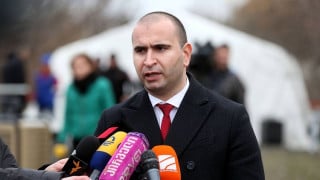Kakha Kemoklidze: “In 2019-2022, the foreign trade with Russia to the GDP ratio increased from 11% to 18%.”
Verdict: FactCheck concludes that Kakha Kemoklidze’s statement is HALF TRUE.
Resume:
The For Georgia party’s Political Secretary, Kakha Kemoklidze, in his assessment of the trade dependency on Russia, stated that trade turnover with Russia in 2019 amounted to 11% of Georgia’s GDP whilst this figure increased to 18% in 2022.
Kakha Kemoklidze provided statistics on the growing dependence on Russia in foreign trade as an argument of discussion for the possible change in Georgia’s foreign policy vector. Within the framework of this article, FactCheck will refrain from making judgements on the assessment part and will be confined to an analysis of the factually verifiable parts alone. FactCheck does not express its opinion about a possible shift of the country’s foreign policy vector and does not interpret the growth or the reduction of trade dependency as a sufficient indicator in order to measure a change or a continuity of a foreign policy orientation. Therefore, the verdict given to this statement should in no way be perceived as giving an opinion about the country’s possible change of its foreign policy vector. The aim of this article is to provide a verification of the factual accuracy of the figures provided by Kakha Kemoklidze.
In fact, Georgia’s GDP in 2019 amounted to USD 17.5 billion and the trade turnover with Russia was USD 1.473 billion which constituted 8.4% of the GDP. The National Statistics Office of Georgia has not yet released official information about the 2022 GDP. However, the most recent forecast (Basic Economic and Financial Indicators – Basic Scenario) was published by the Ministry of Finance, simultaneously with approving the 2023 state budget where the forecast nominal GDP for 2022 will be USD 24.7 billion. At the same time, trade turnover with Russia in 2022 was USD 2.487 billion and the trade to the GDP ratio amounts to 10.1% which is much lower as compared to 18% as claimed by Mr Kemoklidze.
Therefore, figures provided by For Georgia’s party leader substantially differ from reality, although there is a certain growth trend discernible in the aforementioned timeframe. At the same time, this was a growing trend prior to 2019 as well. Therefore, FactCheck concludes that the context of Kakha Kemoklidze’s statement in regard to the growing dependence on the Russian market and threats coming from this predicament is true. Therefore, FactCheck concludes that Kakha Kemoklidze’s statement is HALF TRUE.
Analysis:
On 24 January 2022, on air on TV Pirveli’s talk show. Dghis Ambebi, the political secretary of the For Georgia party, Kakha Kemoklidze, stated: “Eventually, to what extent did (the foreign trade figure with Russia increase vis-à-vis the Georgian economy in 2022 as compared to 2022? In 2019 it was 11%. I take 2019 because it was the pre-COVID period when the economic drive was at its peak and in 2022 it became 18%. Do you know what that means? This means that you are seven percent, eight percent more vulnerable (dependent) on Russia and its military-strategic interests because the Russian economy and security field are integrated with each other.”
According to the National Statistics Office of Georgia, Georgia’s GDP was USD 17.5 billion in 2019. It was also reported that Georgia exported USD 497 million in products to Russia in 2019 and imported USD 976 million products from Russia in the same year. In other words, trade turnover amounted to USD 1.473 billion which was 8.4% of the nominal GDP of that year.
In 2022, Georgia’s export to Russia reached USD 652 million whilst import rose to USD 1.835 billion with the total trade turnover at USD 2.487 billion. As opposed to foreign trade statistics, the 2022 GDP figure has not yet been published, although according to the Basic Economic and Financial Indicators (Basic Scenario) published by the Ministry of Finance, simultaneously with approving the 2023 state budget, the nominal GDP for 2022 will be USD 24.7 billion. According to the same assessment, Georgia’s trade turnover with Russia in 2022 amounts to 10.1% of the country’s GDP.
Naturally, GDP figures will be adjusted further but in order to make Kakha Kemoklidze’s claim that the trade with Russia to the GDP ratio is 18%, the nominal GDP should become USD 13.8 billion. However, such a sharp contraction of the USD-denominated real GDP – when there is a positive economic growth – could only have happened because of a drastic depreciation of the national currency. In fact, however, GEL appreciated against USD by 12.6% from 3.09 to 2.7 and based on preliminary reports, the economic growth rate is 10.1%. Georgia’s GDP in 2021 was USD 18.6 billion and, therefore, in light of the GEL appreciation and economic growth, such an adjustment becomes virtually impossible.
Kakha Kemoklidze takes 2019 – the last year before the pandemic – as the point of departure. However, in order to discern a relevant trend, it would be more relevant to take a broader measurement period which hypothetically could be the start of the Georgian Dream’s second term in power. As before 2013 most Georgian products were banned from the Russian market, the trade volume would naturally be lower. In 2012, the value of the trade turnover with Russia was USD 435 million which amounted to 2.6% of Georgia’s GDP. Since 2013, trade and economic relations between Georgia and Russia expanded significantly.
In 2017-2022, the trade turnover with Russia increased from USD 1.184 billion to USD 2.487 billion and as part of the GDP it rose from 7.3% to 10.1%.
Graph 1: Georgia’s Trade Turnover with Russia (USD Million)

Source: National Statistics Office of Georgia, Ministry of Finance of Georgia
The major reason why the trade turnover with Russia amounted to 10.1% of Georgia’s GDP in 2022 was because of higher oil prices on the world market. As compared to 2021, the import of petroleum products from all countries increased by 62% from USD 823 million to USD 1.136 billion in 2022, including a 361% growth from Russia from USD 135 million to USD 623 million. Since Russian oil was relatively cheaper, the import of fuel from Russia increased by 192% from 225,000 tonnes to 657,000 tonnes.
Therefore, Kakha Kemoklidze’s figures substantially differ from reality, although there is a certain growth trend discernible in the aforementioned timeframe. At the same time, this was a growing trend prior to 2019 as well. Therefore, FactCheck concludes that the context of Kakha Kemoklidze’s statement in regard to growing dependence on Russian market and threats coming from this predicament is true. Therefore, FactCheck concludes that Kakha Kemoklidze’s statement is HALF TRUE.








